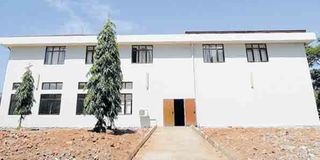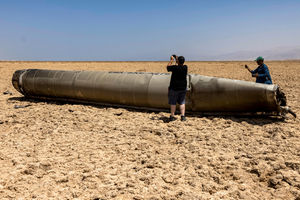SPECIAL REPORT : Cancer cases soar, yet Tanzania radiotherapy hub stands idle

Bugando Medical Centre’s oncology wing.
What you need to know:
- Medical staff at Bugando, a tertiary care and teaching hospital in Tanzania’s second largest city, Mwanza, are keen to start offering radiotherapy to the growing number of cancer patients arriving at the hospital’s doors.
- In 2014, the government helped to build a state-of-the-art oncology wing at the hospital to make it a regional hub for cancer treatment, complete with several bunkers to house radioactive material safely.
Mwanza. The white bulk of the cobalt-60 radiotherapy machine is just visible inside the dark cement bunker. The electricity in the room at Bugando Medical Centre is shut off. The machine, donated last year by the Indian government, looks ready to go, but it has yet to deliver a life-saving dose of radiation.
Medical staff at Bugando, a tertiary care and teaching hospital in Tanzania’s second largest city, Mwanza, are keen to start offering radiotherapy to the growing number of cancer patients arriving at the hospital’s doors.
In 2014, the government helped to build a state-of-the-art oncology wing at the hospital to make it a regional hub for cancer treatment, complete with several bunkers to house radioactive material safely.
But getting the expensive technology up and running has been a long struggle. In the wing’s main hall, two more donated machines – used linear accelerators from Italy and the US – are sitting in a jumble of parts, waiting for the hospital to secure the funds to install them.
Bugando is a lifeline for the 13 million-strong population of northern Tanzania’s Lake Victoria region, providing specialised care no other hospital around can offer. But like many other parts of the country’s healthcare system, this centre – run by the government and the Catholic church – faces staff and equipment shortages that limit what it can do.
Last year, Tanzania’s government allocated 11.3 per cent of the national budget to health. That percentage, which includes significant donor funding, has been rising modestly, but it still falls short of the 2001 Abuja declaration, in which African nations pledged to set a target of spending 15 per cent of their budgets on health. There are fewer than five skilled health professionals per 10,000 people in Tanzania, compared with the regional average of 14.1.
That shortfall is particularly glaring when it comes to cancer diagnosis and treatment. The World Health Organization warned recently that non-communicable diseases are likely to kill more people in Africa than infectious disease by 2030, and Bugando is on the frontline of this fight.
Dr Nestory Masalu, one of Tanzania’s only internationally trained medical oncologist, helped set up the oncology ward in 2009; in 2010 he saw 320 cancer cases. Last year, he and his colleagues saw 14,000.
“Cancer is exploding,” says Dr Merchades Bugimbi, Bugando’s acting director. “Everyone is asking, ‘Why, why, why?’”
The answer is not straightforward. Doctors and health workers in the Mwanza region attribute the spike to poor health education, environmental changes, high HIV rates, improved diagnostics and the fact that people are simply living longer.
In late February, Dodo Boniface, a farmer who lives 170km (105 miles) from Mwanza, stood in the new oncology wing, holding his four-year-old daughter, Dainess. In January, Dainess started complaining about pain in her back. Within days, she had lost use of her legs. The family was referred to Bugando, where she was diagnosed with lymphoma that had moved into her spine. “We’ve really struggled with this,” says Boniface.
Bugando is the only hospital in the region that can do biopsies and has its own pathology lab; the team here can also perform complex surgeries and offer chemotherapy. But the centre still has limitations: the hospital does not have MRI or a functional CT scan machine to investigate and diagnose certain kinds of cancer, according to staff.
Dainess’ family isn’t insured, but sold some cattle to pay for her scans at a private clinic. Now they’ve been advised she should start a course of chemotherapy. Since 2015, the US-based International Cancer Care and Research Excellence Foundation (Iccare) has subsidised chemotherapy for paediatric patients at Bugando. The programme collaborates with the Duke Global Health Institute at Duke University, which is working on strengthening cancer treatment in Bugando and in other parts of Tanzania.
It’s not always easy to get cancer patients to keep coming back. Many don’t have the money to get to the hospital or stay for treatment. Others worry that the illness is a curse, and prefer to consult traditional doctors. When Iccare first started its programme, half the paediatric cancer patients abandoned treatment mid-course. The programme has reduced that number by 20 per cent.
“If you diagnose patients with cancer, they don’t accept it,” says Dr Beda Likonda, Bugando’s radiation oncologist. “It’s like a denial. They look for other options.” By the time many do seek treatment, their cancer is advanced.
Dainess can be treated at Bugando, but many others cannot. Masalu, the medical oncologist, estimates that 60 per cent of new cases at Bugando require radiotherapy. The radiotherapy machine in the bunker may soon be ready, says Likonda, but it’s older technology and a blunter instrument than the linear accelerators languishing in storage. Together, those two machines will take a few million dollars to install and maintain, he says.
For now, Bugando patients who require radiation are referred to Ocean Road Cancer Institute in Dar es Salaam, more than 1,000km away and home to the country’s only radiotherapy treatment centre. Making the journey once is daunting and expensive, let alone going back and forth for the required cycles of therapy. “They are told to go back home, and come back in one month,” says Masalu. “They can’t.”
Rahel Charles Rosana, a 49-year-old widow who lives about 70km outside Mwanza, hasn’t been able to go anywhere for a long time. By the time Rosana was examined for cervical cancer at a local health centre, she had been having such intense abdominal pain that she hadn’t slept lying down for five years. The health workers suspected she had cancer and referred her to Bugando, but she struggled to pay for even one visit.
“I can’t afford to go back,” Rosana says, visibly uncomfortable in a chair in her small village. If she were referred to Dar for radiotherapy, a common treatment for cervical cancer, there would be no way for her to get there.
Cervical cancer has emerged as the most common cancer in Tanzania – and the leading cause of cancer-related deaths. Eighty percent of Tanzanian women are diagnosed at an advanced stage, according to Pink Ribbon Red Ribbon, a US-based non-profit. The mortality rate for the disease, which is treatable and curable if caught early, could be as high as 44 per cent, according Dr Safina Yuma, cervical cancer specialist at the health ministry.
“This disease is killing more women than die in childbirth,” says Celina Schocken, Pink Ribbon Red Ribbon’s CEO. “It has an incredibly high disease burden and gets very little donor funding.” Pink Ribbon Red Ribbon and its partners have been helping the government to improve screening and health worker training to catch cervical cancer earlier. Around Mwanza, where rates are especially high, they help pay for treatment and transportation for women to get to Bugando or Ocean Road in Dar es Salaam. The group is also planning to build hostels for cancer patients to stay in both cities to relieve expenses during long treatments.
At Makongoro Health Centre in Mwanza, Dr Goret Dussa says she was trained under one of these programmes to do screening and cryotherapy, a simple, early treatment that uses gas to freeze pre-cancerous cells on the cervix. “Before this, we didn’t know how to do it,” Dussa says.
Dussa was driving out to do screenings and treatment in rural areas outside Mwanza, but the funding has run out. She is also having a problem with the centre’s donated cryotherapy machine, and has been borrowing a machine from another clinic. She’s requested new equipment from the government, but isn’t sure if she’ll get the money.
After all, there is a limit to what any donor or NGO can do. “There’s a five-year project, but then it ends,” says Yuma. “If you develop something and you stop, there’s no meaning to it. We need the government to take over.”
At Bugando, Masalu is banking on the government finally locking down the funds to get the radiation machines up and running to treat women like Rosana closer to home. He has big plans for Bugando’s cancer treatment programme, including the construction of a 120-bed cancer ward next to the oncology wing, and training more young oncologists to join his staff.
“The government is starting to think about non-communicable diseases, especially cancer,” says Bugimbi, the hospital’s acting director. The radiation programme, he admits, is stuck for now. But he adds, “Always, we try.”
Source:The Guardian UK




